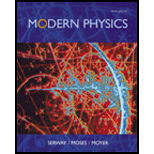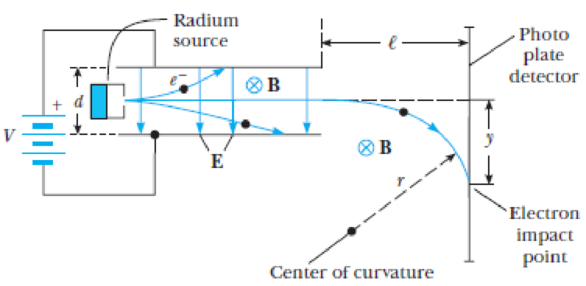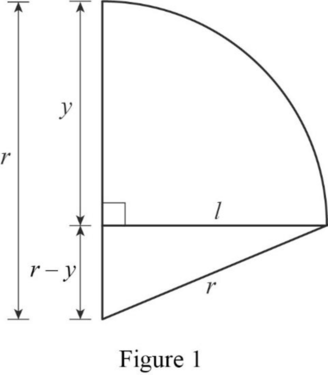
A Thomson-type experiment with relativistic electrons. One of the earliest experiments to show that p = γmv (rather than p = mv) was that of Neumann. [G. Neumann, Ann. Physik 45:529 (1914)]. The apparatus shown in Figure P4.5 is identical to Thomson’s except that the source of high-speed electrons is a radioactive radium source and the magnetic field B is arranged to act on the electron over its entire trajectory from source to detector. The combined electric and magnetic fields act as a velocity selector, only passing electrons with speed v, where v = V/Bd (Equation 4.6), while in the region where there is only a magnetic field the electron moves in a circle of radius r, with r given by p = Bre. This latter region (E = 0, B = constant) acts as a momentum selector because electrons with larger momenta have paths with larger radii. (a) Show that the radius of the circle described by the electron is given by r = (l2 + y2)/2y. (b) Typical values for the Neumann experiment were d = 2.51 × 10−4 m, B = 0.0177 T, and l = 0.0247 m. For V = 1060 V, y, the most critical value, was measured to be 0.0024 ± 0.0005 m. Show that these values disagree with the y value calculated from p = mv but agree with the y value calculated from p = γmv within experimental error. (Hint: Find v from Equation 4.6, use mv = Bre or γmv = Bre to find r, and use r to find y.)

Figure P4.5 The Neumann apparatus.
(a)
To show that the radius of the circle described by th electron is given by
Answer to Problem 5P
It is showed that the radius of the circle described by th electron is given by
Explanation of Solution
The curved path of the electron is shown in figure 1.

Write the equation for the curved path of the electron.
Here,
Rewrite the above equation.
Rewrite the above equation for
Conclusion:
Therefore, it is showed that the radius of the circle described by th electron is given by
(b)
To show that the value of
Answer to Problem 5P
It is showed that the calculated that the value of
Explanation of Solution
Write the equation for the velocity of the electron.
Here,
Write the equation for the momentum of the electron.
Here,
Write the classical expression for the momentum of a particle.
Here,
Equate equations (III) and (IV) and rewrite it for
Write the relativistic equation for the momentum of the particle.
Here,
Equate equations (III) and (VI) and rewrite it for
Write the equation for the Lorentz factor.
Here,
Put the above equation in equation (VII).
Write the equation for the root of a quadratic equation
Conclusion:
The mass of the electron is
Substitute
Substitute
Substitute
Comparison of the above equation with the quadratic equation
Substitute
The value
The value
Substitute
Substitute
Comparison of the above equation with the quadratic equation
Substitute
The value
The value
Therefore, it is showed that the calculated that the value of
Want to see more full solutions like this?
Chapter 4 Solutions
Modern Physics
- You set out to reproduce Thomson’s e/m experiment with an accelerating potential of 150 V and a deflecting electric field of magnitude 6.0 * 10^6 N/C. (a) How fast do the electrons move? (b) What magnetic-field magnitude will yield zero beam deflection? (c) With this magnetic field, how will the electron beam behave if you increase the accelerating potential above 150 V?arrow_forwardThe beam of electrons goes undeflected when passing through crossed electric and magnetic fields of magnitude 6x104 V/m and 1x10-3 T, respectively. What is the radius of the electron orbit, in mm, if the electric field is turned off? Give your answer to 2 decimals.arrow_forwardThe least massive particle known to exist is the electron neutrino. Though scientists once believed that it had no mass, like the photon, they have now determined that this particle has an extremely low mass, equivalent to a few electron volts. Assuming a mass of 2.2 eV/c2 (or 3.9 × 10-36 kg) and a speed of 4.4 × 106 m/s, which of the following values equals the neutrino’s de Broglie wavelength? a. 3.8 × 10-5 m b. 4.7 × 10-7m c. 1.7 × 10-10m d. 8.9 × 10-14marrow_forward
- A 2.50 MeV electron moves perpendicularly to a magnetic field in a path with a 3.0 cm radius of curvature.What is the magnetic field B?arrow_forwardA) What is the approximate wavelength emitted from helium represented by the bright yellow emission line below? What is it's frequency in HZ and energy in eV? (1 eV= 1.6 x 10-19 joules). B) If the excited helium electron that emits a yellow photon in this line starts with a potential energy of 8 eV, what is the potential energy of the electron afterwards? Assume that the emission of a yellow photon is allowed by the laws of quantum mechanics. Also don't worry about the other electron.arrow_forwardA-2.0-mC charge is moving with a velocity given asv=(20,0,-15)m/s in the presence of a magnetic fieldB=(2,-7,3)Tesla.What is the x-component of themagnetic force on that charge?You may usearrow_forward
- The deflector plates of a Thomson appliance are 6.0 cm long and separated by 1.2 cm. The distance between the front edge of the plate and the tube is 30.0 cm. The energy assigned to the electrons of the beam is 2.8 keV (can make an illustration for a good understanding) (a) If the potential of 25 V is applied to the deflector plates, what will be the deviation of the beam on the screen? (b) Find the module of the crossed magnetic field that would allow the beam to pass through the plates, without suffering any deviation. Answer a) 7.36 mm b) 6.64 x 10^ - 5 Tarrow_forwardA proton in a linear accelerator has a de Broglie wavelength of 117 pm. What is the speed of the proton? Express your answer with the appropriate units.arrow_forwardA 0.7 mm diameter superconducting wire is composed of half copper and half superconductor. At 3.2 T it is capable of carrying 2110 Amps. Assume 4.5 cm of that wire slides perpendicularly to the magnetic field due to the Lorentz forces. How far, in meters, did the wire slide to generate 0.002 J heat, assuming all the frictional energy was converted to heat in the section of wire?arrow_forward
- A neutron of mass 1.675 × 10-27 kg has a de Broglie wavelength of 7.8x10-12 m. What is the kinetic energy (in eV) of this non-relativistic neutron? Please give your answer with two decimal places. 1 eV = 1.60 × 10-19 J, h = 6.626 × 10-34 J ∙ s.arrow_forwardA photon in a laboratory experiment has anenergy of 11 eV. What is the frequency of this photon?Planck’s constant is 6.63 × 10−34 J · s.Answer in units of Hz.arrow_forwardA photon in a laboratory experiment has anenergy of 11 eV.What is the frequency of this photon?Planck’s constant is 6.63 × 10−34 J · s.Answer in units of Hz.arrow_forward
